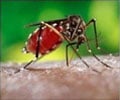Elementary cytoskeleton protein is different in parasites and represents a starting point for a possible new therapy against malaria infections.

‘Malaria parasites are ten times nimbler than the fastest of our immune cells and literally outrun our immune defences.’





How does the malaria parasite move so fast? Like Lego blocks, which can be put together into long chains, actin is assembled into long rope-like structures called filaments. These filaments are important for the proper functioning of cells - such as muscle cells - and enable each of our movements. However, they also serve to enable immune system cells to move and capture invading pathogens. Likewise, they are of great importance for the movement of the malaria parasite. “If we understand this important difference in movement, we can target and stop the parasite," says Dr. Ross Douglas from the Heidelberg Centre for Infectious Diseases.
Mammal-parasite protein hybrids lead to new insights
It was known that certain sections of the actin protein differ between the parasite and mammals. To investigate the reasons behind the difference in speed, scientists replaced parts of the parasite protein with corresponding sections of protein from mammalian actin in the laboratory. "When we made these changes in the parasite, we noticed that some parasites could not survive at all and others suddenly hesitated when they moved," says Dr. Ross Douglas. To investigate the underlying mechanism, the participating scientists performed experiments and computer simulations ranging from modeling at the molecular level to observing the parasites in live animals. "High-performance computers were required for simulations to observe how the structure and dynamics of actin filaments change when individual sections are swapped," says Prof. Rebecca Wade, who heads research groups at the Heidelberg Institute for Theoretical Studies (HITS) and at the Centre for Molecular Biology (ZMBH) at Heidelberg University that investigate protein interactions via computer simulations and mathematical modelling.
These findings could now be used to discover chemical compounds that selectively target parasite actin and affect either the building or breakdown of the filament. "In this way, it could be possible to effectively stop the entire parasite," Dr. Ross Douglas summarizes. An example for this approach is tubulin, another type of protein which is involved in the building of the cytoskeleton via so-called microtubules. Medicines that target parasite microtubules - such as mebendazole - have been successfully used for decades to treat humans and animals for parasitic worms. This joint research project was partially funded by the innovation fund FRONTIER at Heidelberg University.
Advertisement













